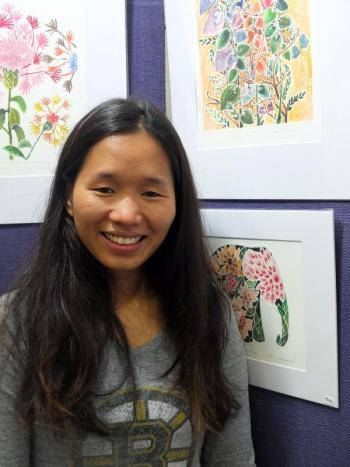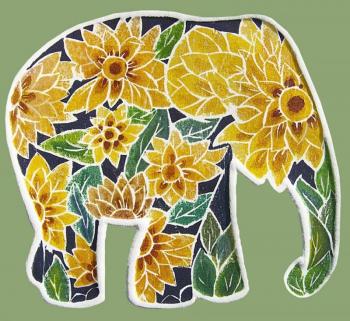Following the white line
As an artist and student in Thailand, Lek Saruta enjoyed the detailed work of etching.
She didn't, however, enjoy the odor of the inks and use of toxic chemicals involved with the art form. And, she said, at school, the printing press area was “very dirty.”
So when Saruta began an internship with Kim and Philippe Villard early this summer to learn whiteline woodblock printing, she first looked for the Villard’s printing press.
“I thought I should bring my mask to protect myself. I was surprised they did not use (a) press and inks; (the studio) did not smell bad there. But I still wasn't sure about what they did.”
The first day, after taking a look at Saruta's portfolio, Kim and Philippe Villard soon realized their new intern was quite talented in drawing, and was a skilled renderer. Saruta, of the Akha Hill Tribes in Northern Thailand, holds a degree in fine arts from Rajamangala University of Technology Lanna in Chiang Mai.
The artists showed Saruta how prints were made at their studio using some of the “public domain” blocks created for hands-on use at events and by visitors to their studio.
“We realized, almost immediately, that her designs, not just on a graphic arts level, but in a sort of strangely exotic level, had something that would go with this woodcut technique very easily,” Kim Villard said. “It seemed like a good match.”
Saruta's mentors also quickly learned she was uncomfortable with using color. A color theory segment was in order.
“She picked it up really quickly,” Kim Villard said. “By her third day she had cut three original woodblocks and was making prints.”
Kim suggested Saruta go outside and draw from nature as part of the curriculum. Surrounded by lupines and trees, Saruta found herself connecting with the out of doors.
“I think it's good to see many things,” Saruta said. “The centaurea flower I really liked. It was all purples, but I can create my own color for it. I felt relaxed and happy. Very happy.”
“It was a real turning point,” Kim said.
Saruta's attraction to the centaurea (a type of cornflower) became a whiteline woodblock.
Saruta's botanical florals grace her note-card collection and larger design prints.
Kim said Saruta is an active sketcher who will pick up whatever is handy to draw on — whether it happens to be paper or a rock.
“I sketch fast before my ideas are gone,” Saruta said, laughing, “or I'll write (it down). I am always thinking about designs.”
One day, while she was thinking about other, larger designs, Saruta found inspiration in a piece Philippe Villard had created of a free-standing bird.
“I love flowers, but wanted to do something special,” Saruta said. “I chose the elephant because it is a sacred mammal in Thailand.”
The elephant became the frame for her botanical floral designs, the first being a sunflower elephant. The sunflower, too, has special meaning for Saruta. She stayed at Friends of Thai Daughters’ Sunflower House while attending school. It was her safe place and her home.
FTD is dedicated to preventing child trafficking in Thailand, and Saruta first came to Maine at a young age as a “daughter.”
When FTD founders and Barters Island residents Jane McBride and Patty Zinkowski saw the sunflower elephant, they fell in love with it.
The group has long used the sunflower for its logos. The two women had already been planning to develop a new logo for FTD, and using one designed and created by one of their “daughters,” was nothing less than perfect.
All of the works Saruta had been creating over the summer were in her first show ever on Aug. 21 at the Barters Island Community Hall.
Saruta's works were embossed with her very own “chop,” an artist's unique logo — a gift from the Villards — appears on every work.
The Aug. 21 event was also a thank-you to the 2013 FTD donors, and included a silent and a live auction, and authentic Thai cuisine.
Since that show, and thanks to orders stemming from Facebook, Saruta has been filling orders and creating new designs.
Saruta also had the good fortune to be in a second show with the Villards at the Arts & Yachts Show in Southport over Labor Day weekend.
“I never saw an art exhibition before,” Saruta said. “They are very expensive to attend in Thailand. I think it is good to see what others are doing.”
Saruta has kept in touch with her school adviser and friends in Thailand via email, Skype and Facebook. When she showed her adviser the whiteline woodblock technique, he asked her to be a guest teacher of the art form when she returns.
Saruta said she hopes that in two years’ time, she will have saved enough money for a small studio/gallery in Thailand. There, she will teach the whiteline technique and exhibit her friends' art and her own.
“In Thailand, only the wealthy can afford to attend art shows and own galleries,” Saruta said. “It will be good for hill tribe people who cannot go to the city. It will be really good.”
Until she leaves for her return trip to Chiang Mai, Saruta is at Villard Studios, 53-57 Campbell Street in Boothbay Harbor, on Mondays, Wednesdays and Fridays.
For more information on this art form, visit www.villardstudios.com.
For more information on Friends of Thai Daughters, visit www.friendsofthaidaughters.org.
For more background on Saruta, read the press release by Julie Lamy in the July 17 edition of the Boothbay Register: http://www.boothbayregister.com/article/thai-artist-finds-future-career-...
































